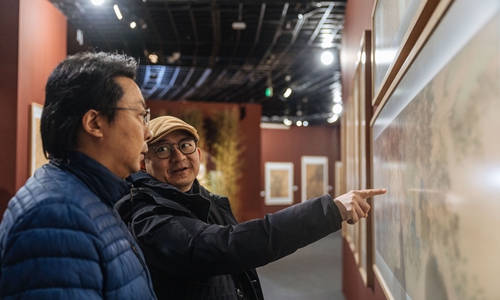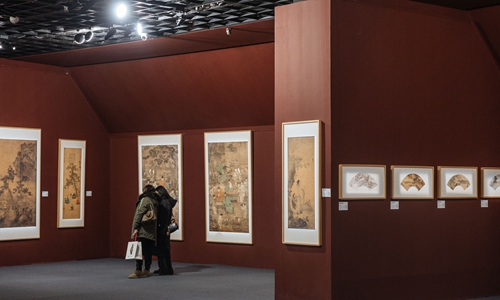ARTS / CULTURE & LEISURE
China’s latest exhibition showcases its rich and enduring cultural heritage
Snapshot of history

Two visitors discuss an art piece at the Thematic Exhibition of Comprehensive Collection of Ancient Chinese Paintings held at the Beijing World Art Museum in Beijing, China, on January 22, 2024. Photo: Li Hao/GT
A visitor is intensely studying a painting, being careful not to miss a single detail. From her intense concentration, one can tell that the painting is special. It is the Admonitions of the Instructress to the Court Ladies, a masterpiece by ancient Chinese painter Gu Kaizhi, widely considered to be of particular importance in Chinese art history.
While the original painting is housed in the British Museum in London, a digitized version has been put on display as part of the Thematic Exhibition of Comprehensive Collection of Ancient Chinese Paintings at the Beijing World Art Museum.
With a deep exploration of the compilation and publishing results of the Comprehensive Collection of Ancient Chinese Paintings, the exhibition "selects works under the theme of reading" and takes the compilation process of the collection as its main through line, Gao Jing, the curator of the exhibition, told the Global Times.
The Comprehensive Collection of Ancient Chinese Paintings, a project by Zhejiang University and the Zhejiang Provincial Administration of Cultural Heritage, is by far the world's most comprehensive collection of ancient Chinese paintings. Over the course of 18 years, the project has gathered over 12,000 pieces of Chinese paintings on various materials such as paper, silk (including brocade and damask), linen, and more, from 263 museums and other cultural institutions at home and abroad. The project encompasses a significant portion of China's national treasures throughout history.
It is a remarkable achievement that showcases the cooperation between Zhejiang and the outside world, demonstrating humanity's commitment to preserving, inheriting, and popularizing civilization. These collections are currently the most complete and extensive compilations of illustrated Chinese paintings available.
To illustrate the challenges faced during this large-scale global project, we can take the precious Admonitions of the Instructress to the Court Ladies as an example. Despite the British Museum's cooperation in providing pictures of this Chinese cultural treasure, it didn't meet the requirements of the project, said Yu Changwei, the graphic editor of the Comprehensive Collection of Ancient Chinese Paintings. Yu and his colleagues had to invest significant time and effort in post-editing and printing multiple copies before finally finding one that met their exacting standards.
Since the project's inception, the world's most advanced photography and digital scanning technology have been introduced to copy and store data from the showcased art pieces. For audiences, the project provides an accurate and clear viewing experience, and some images have been partially enlarged to reveal many details that are difficult to notice in the original works. Through the application of digital technology, the team has also successfully identified and extracted images, inscriptions, and seals that were originally faded and difficult to appreciate with the naked eye, especially in the case of many ancient paintings.
Detailed digital files are established one by one, so that for the first time, fine Chinese paintings scattered around the world can obtain "digital substitutes" that are infinitely closer in quality to the original works, opening a new window and space for research and innovative use.
The publishing of the Comprehensive Collection of Ancient Chinese Paintings helps "solve the lack of systematic collecting of ancient Chinese paintings in academic circles and can aid in the better study of the cultural genes and spiritual codes of Chinese civilization through paintings, while also serving to popularize China's fine traditional culture," Chen Ye, a professor at Zhejiang University, told the Global Times.
As observed by Global Times reporters, these high-definition prints and paintings from China's various dynasties, ranging from the Song (960-1127) to the Qing (1644-1911), depict the elegant and vibrant lives of ancient people and scholars in the landscape of ink and water. They showcase civil culture, lifelike birds, animals, fish, insects, unique plums, orchids, bamboo, and more.
The exhibition is scheduled to run until May 5. Divided into four sections, "Elegance in Reading," "Interest in Study," "Appreciation of Classics," and "Appreciating the Past and Creating New Ones," the exhibition displays various images and scenes of reading portrayed in the paintings, hoping that the audience can contextualize the pieces in ways that transcend time and space, added Gao.
The integration of classic paintings and reading "allows the public to immerse themselves in the Chinese cultural system, and experience and inherit Chinese culture," Wu Hongliang, president of Beijing Fine Art Academy, told the Global Times. Starting from the Complete Collection of Song Dynasty Paintings, the Comprehensive Collection of Ancient Chinese Paintings is "not only about the paintings themselves but also extends to the recognition of Chinese people toward reading and culture inheritance," noted Wu.
Ancient Chinese paintings featuring reading scenes have a long history, and an endless stream of fine works has been passed down from generation to generation. However, for a long time, they have rarely been displayed. Especially in modern society, these paintings are not often mentioned, and it is also difficult for the public to get the opportunity to appreciate them, according to Nie Zhenning, former president of China Publishing Group, in his speech on Monday at the exhibition's opening.
"The new digital media methods help the audience to appreciate ancient paintings in classics and read classics in ancient paintings. As we can see, the creative transformation and innovative development promote public reading," said Nie.

Visitors appreciate artworks on exhibition at the Thematic Exhibition of Comprehensive Collection of Ancient Chinese Paintings held at the Beijing World Art Museum in Beijing, China, on January 22, 2024. Photo: Li Hao/GT




